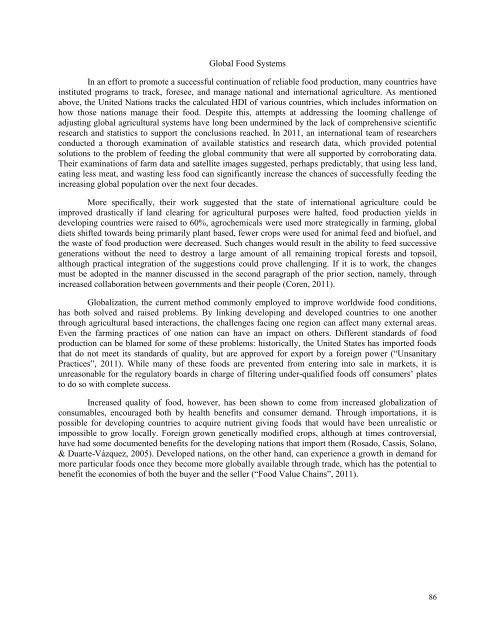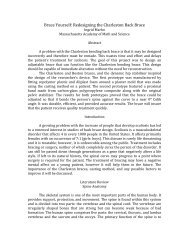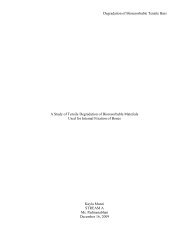Got Food? - the Scientia Review
Got Food? - the Scientia Review
Got Food? - the Scientia Review
You also want an ePaper? Increase the reach of your titles
YUMPU automatically turns print PDFs into web optimized ePapers that Google loves.
Global <strong>Food</strong> Systems<br />
In an effort to promote a successful continuation of reliable food production, many countries have<br />
instituted programs to track, foresee, and manage national and international agriculture. As mentioned<br />
above, <strong>the</strong> United Nations tracks <strong>the</strong> calculated HDI of various countries, which includes information on<br />
how those nations manage <strong>the</strong>ir food. Despite this, attempts at addressing <strong>the</strong> looming challenge of<br />
adjusting global agricultural systems have long been undermined by <strong>the</strong> lack of comprehensive scientific<br />
research and statistics to support <strong>the</strong> conclusions reached. In 2011, an international team of researchers<br />
conducted a thorough examination of available statistics and research data, which provided potential<br />
solutions to <strong>the</strong> problem of feeding <strong>the</strong> global community that were all supported by corroborating data.<br />
Their examinations of farm data and satellite images suggested, perhaps predictably, that using less land,<br />
eating less meat, and wasting less food can significantly increase <strong>the</strong> chances of successfully feeding <strong>the</strong><br />
increasing global population over <strong>the</strong> next four decades.<br />
More specifically, <strong>the</strong>ir work suggested that <strong>the</strong> state of international agriculture could be<br />
improved drastically if land clearing for agricultural purposes were halted, food production yields in<br />
developing countries were raised to 60%, agrochemicals were used more strategically in farming, global<br />
diets shifted towards being primarily plant based, fewer crops were used for animal feed and biofuel, and<br />
<strong>the</strong> waste of food production were decreased. Such changes would result in <strong>the</strong> ability to feed successive<br />
generations without <strong>the</strong> need to destroy a large amount of all remaining tropical forests and topsoil,<br />
although practical integration of <strong>the</strong> suggestions could prove challenging. If it is to work, <strong>the</strong> changes<br />
must be adopted in <strong>the</strong> manner discussed in <strong>the</strong> second paragraph of <strong>the</strong> prior section, namely, through<br />
increased collaboration between governments and <strong>the</strong>ir people (Coren, 2011).<br />
Globalization, <strong>the</strong> current method commonly employed to improve worldwide food conditions,<br />
has both solved and raised problems. By linking developing and developed countries to one ano<strong>the</strong>r<br />
through agricultural based interactions, <strong>the</strong> challenges facing one region can affect many external areas.<br />
Even <strong>the</strong> farming practices of one nation can have an impact on o<strong>the</strong>rs. Different standards of food<br />
production can be blamed for some of <strong>the</strong>se problems: historically, <strong>the</strong> United States has imported foods<br />
that do not meet its standards of quality, but are approved for export by a foreign power (―Unsanitary<br />
Practices‖, 2011). While many of <strong>the</strong>se foods are prevented from entering into sale in markets, it is<br />
unreasonable for <strong>the</strong> regulatory boards in charge of filtering under-qualified foods off consumers‘ plates<br />
to do so with complete success.<br />
Increased quality of food, however, has been shown to come from increased globalization of<br />
consumables, encouraged both by health benefits and consumer demand. Through importations, it is<br />
possible for developing countries to acquire nutrient giving foods that would have been unrealistic or<br />
impossible to grow locally. Foreign grown genetically modified crops, although at times controversial,<br />
have had some documented benefits for <strong>the</strong> developing nations that import <strong>the</strong>m (Rosado, Cassís, Solano,<br />
& Duarte-Vázquez, 2005). Developed nations, on <strong>the</strong> o<strong>the</strong>r hand, can experience a growth in demand for<br />
more particular foods once <strong>the</strong>y become more globally available through trade, which has <strong>the</strong> potential to<br />
benefit <strong>the</strong> economies of both <strong>the</strong> buyer and <strong>the</strong> seller (―<strong>Food</strong> Value Chains‖, 2011).<br />
86
















